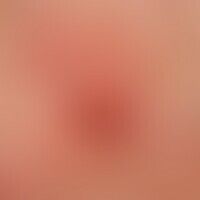Image diagnoses for "red"
901 results with 4543 images
Results forred

Basal cell carcinoma nodular C44.L
Basal cell carcinoma, nodular: Nodule existing for 3 years, completely without symptoms, size: 2.0x 1.8 cm. Sharply defined. 61-year-old female patient.

Neurofibromatosis (overview) Q85.0
Type I neurofibromatosis, peripheral type or classic cutaneous form. massive tumorous transformation of the skin with numerous generalized distributed, soft, skin-colored, partly pointed conical shaped neurofibromas on the left mamma. the CT examination (skull) did not reveal any pathological findings. no neurofibromas known in the family.

Lichen simplex chronicus L28.0

Pityriasis rosea L42
Pityriasis rosea: Characteristic exanthema that exists for a few weeks, only slightly itchy, and orientation in the cleavage lines is visible.

Cylindrome D23.4

Erythronychia longitudinalis; L60.9 L60.8

Chronic venous insufficiency (overview) I87.2
Venous insufficiency chronic: Massive congestive dermatitis with papillomatosius cutis and intial ulcer.

Sézary syndrome C84.1
Sézary Syndrome: universal redness with small-focus recesses. small spotted scaling. massive itching, pain at times. here detailed picture of the right arm

Urticaria chronic spontaneous L50.8
Urticaria chronic spontaneous: chronically recurrent clinical picture, confluent wheals form in a map-like manner.

Acrodermatitis continua suppurativa L40.2
acrodermatitis continua suppurativa. chronic, red, rough plaques with recurrent pustular formation and onychodystrophies. pressure dolence. primary efflorescence (subcorneal pustules) and general symptoms are indicative. in the advanced course, acral skin and bone atrophies were observed in addition to the pronounced onychodystrophies.

Venous leg ulcer I83.0

Steroid acne L70.8

Prurigo gestationis O99.75
Prurigo gestationis: 32-year-old female patient in the 6th month of pregnancy with increasing, severe itching, pruriginous rash; fresh effglorescence is not detectable, only scratched papules.

Balanitis plasmacellularis N48.1
Balanitis plasmacellularis. several months of therapy resistant, itching and burning, sharply defined, bizarrely configured, lacquer-like glossy red plaque on the glans penis and the adjacent preputial leaf in a 66-year-old diabetic. course of the disease has been changing for 1 year, healing in between. at the beginning of the disease several areas were already affected (important differential diagnostic distinction to erythroplasia).

Angiosarcoma of the head and face skin C44.-

Syphilide, ulcerous A51.3
Syphilis: multiple papular or papulo-necrotic, painless syphilis II, untreated!








